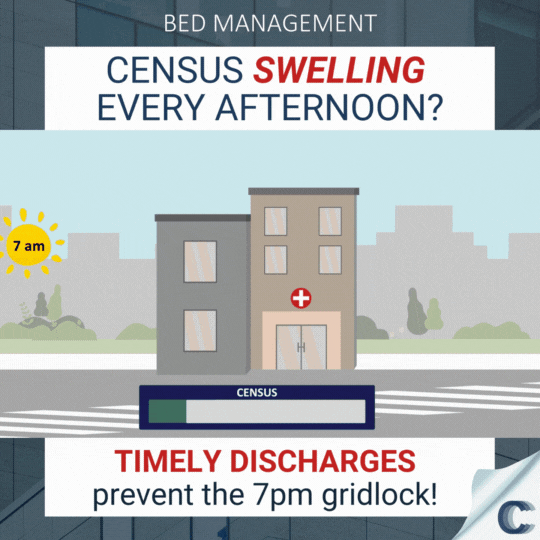bed management top tips
BOARDERS
Is the ER solely responsible for hold hours at your hospital? If so, #youredoingitwrong!
While patients with admission orders waiting to go upstairs for hours or days are physically within the ER, the drivers of their delay has very little to do with the ER itself. The truth about boarders is that they are primarily driven by inefficient processes on the inpatient side, while the ER pays the price.
REMEMBER: every hour that a patient is waiting for a bed in the ER is approximately .25 hours of avoidable RN labor! This means that if your ER is missing their productivity target, it might not even be in their control due to an overflow of inpatients requiring care. As executives, we owe it to the ER - and to our patients - to better understand the drivers of pain points and ensure they have the right staff, at the right place, at the right time to care for these waiting patients.
Follow along in this Top Tip series to learn more about industry best practices for bed management!
#bedmanagement #holdhours #patientflow #capacitymanagement #hospitalthroughput
COLLABORATION
Who is responsible for bed management and patient throughput at your hospital?
Take it from us, problems with so many variables - and responsible parties - are some of the most difficult problems to solve. Even with a stellar bed manager/bed czar/nursing supervisor, this is far from a one-man job. While accountability is an art that few have mastered, managing so many people that do not report to you truly is a next-level challenge.
Try this: Attend an interdisciplinary team round! Who attends to help solve the problems? Does the conversation support streamlined care for our patients? How often do they occur?
#bedmanagement #patientthroughput #streamlinecare #capacitymanagement
BED HUDDLES
Are your bed huddles moving the needle on patient throughput?
If not… we aren't surprised. So many bed board meetings we attend do not seem mindful of the meeting's goal. Most have each department monotonously state how many patients they have, and how many anticipated discharges…but there is no problem solving - and more importantly, no action! If this sounds familiar, it's time to move to a more effective bed huddle model.
In your morning bed huddle, ensure each nursing unit is covering not only their planned discharges, but also the source of delay along with a specific request to resolve. Do we need labs back, a ride home for the patient, a last dose of antibiotics, sign off from the hospitalist? Requiring the right leaders to be in the room is the most effective way to expedite these orders.
During your afternoon huddle, the group should be following up on the morning huddle's discussion, and continuing to problem solve for any newly identified discharges. Best practice is to support a constant conversation, and engaging the night shift in discharge preparation, by holding a 3rd bed huddle at 3am.
Last but not least, if you aren't sure - you can always attend yourself! You might be surprised what you find.
#bedmanagement #bedhuddles #patientthroughput #capacitymanagement
CONDITIONAL DISCHARGES
Are inpatient care teams playing Discharge Hot Potato at your hospital? Answer… PROBABLY
As we work to understand and address avoidable throughput delays (and reduce expensive-and-complication-inducing extended length of stay for our patients), often the best place to start is with the discharge order. When analyzing discharge orders, it is important to understand the subtle, yet critical, difference between conditional and unconditional discharge orders.
- Unconditional discharge orders imply that the patient is ready to go - like right now! No conditions. The physician has cleared this patient for discharge and zero additional information, clearances, or actions are required before their departure.
- Conditional discharge orders imply that something is needed before the patient leaves. This "something" could be almost anything - clearance from a specialist, specific lab results, line removal or almost anything else. These "somethings" are considered discharge delays and should be brought to the bed huddle for troubleshooting and intervention, as discussed in our last post.
If you are feeling overwhelmed in solving this very complex problem, consider first using data to quantify and distinguish between unconditional vs. conditional discharge orders. From here, focus on these things:
- Moving unconditional discharges earlier
- Piloting solutions for the top 2 most common reasons for conditional discharges
#bedmanagement #conditionaldischarges #bedhuddles #patientthroughput
DISCHARGE TIME OF DAY
Already tracking conditional vs. unconditional discharges? Great! Now, you can begin working on the most impactful throughput tactic: Discharge Time of Day.
What time of day are beds requested at your hospital? Your OR probably peaks between 12pm to 4pm and, while we know the ER stays pretty busy admitting between noon to midnight, they typically peak between 3pm to 8pm.
If we need clean and ready beds as early as noon, with a peak is between 3-8pm, what time should we discharge patients to allow housekeeping enough time to clean the rooms? Now you see why many hospitals track discharges before 11am.
Do you know when the majority of your discharges are occurring? If it is after 4pm, you probably have a slew of ER boarders, PACU holds, and an overall gridlock that creates headaches for all involved.
No matter where you are on your bed management journey, discharge time of day will be an ongoing challenge. If you don’t know what time your hospital discharges on average, data discovery is the best place to start!
#bedmanagement #capacitymanagement #bestpractices #hospitalthroughput
BED HIDING
Have you ever rounded upstairs on a Monday at 7:30pm? If so, did you find patients in beds as expected based on your EMR? Or were there empty beds where patients should be, according to the system?
When patients depart, it is critical to discharge patients electronically within the system immediately to avoid delays due to empty beds incorrectly appearing occupied. While this documentation may seem a low priority compared to other discharge activities, the miscommunication driven by missing or delaying this step has a direct impact on patient care. We rely on this communication tool to alert housekeeping to clean the room, and allow the Bed Manager to assign clean and empty beds to patients waiting in a less than ideal care area.
High performing hospitals' Nursing Supervisor or Bed Manager rounds on inpatient units twice per day to identify undocumented discharges to expedite patient flow and ultimately decompress the ER. Try it out and notice the reduction of boarders and patients leaving without being seen from the waiting room!
#bedmanagement #hidingbeds #hospitalthroughput #capacitymanagement
EVS: HEROES OF THE NIGHT
Environmental Services appreciation post!!
Often out of sight and commonly taken for granted, this impressive team carries the water for us all when it comes to hospital capacity management - ESPECIALLY between 3pm and 10pm M-F.
As we work to reduce ER boarder time, inpatient room turnover times become a primary focus area. This is because, even if we succeed in getting an inpatient bed open, we cannot place a patient until it is cleaned! This is where Environmental Services (EVS) steps in.
To ensure EVS team members are supported, make sure we have the right number of staff to quickly turn rooms. Learn more from our Demand Matching video: https://youtu.be/wuSW7hxZV_o?si=aEoyrnCHAgdLZh9x.
Tell an EVS team member you appreciate them today!
#bedmanagement #environmentalservices #EVS #patientthroughput #capacitymanagement
OUTLIERS ARE PATIENTS TOO
How long is too long to wait for an inpatient bed? Well, it depends on your perspective.
As a leader viewing data in a report, you might not think much of a 24+ hour wait, but for a sick patient in a chaotic ER's hallway bed, even 30 minutes feels like forever.
Do you know how many admitted patients waiting longer than 12 hours in the ER for an IP bed? What about 24? How long was the longest wait last month?
This is why it's important to think critically about dashboard design. Which metrics tell the story we need to hear, with respect to hold times? Consider reporting average hold time per patient as well as the distribution of hold times.
Leveraging this data for a better understanding of patient experience in your ER can inspire great change!
#bedmanagement #patientswaiting #ERdashboard #patientthroughput
SURGE PLANNING
Want to freak yourself out this Halloween?! Ask to review your surge plan!
Hospital surge capacity plans are the only thing standing between current state and a lot worse than diversion. Your hospital surge capacity plan should define saturation levels using easily measurable triggers such as hospital census, ED census, # ED boarders, hold times, etc. When these triggers are tripped, everyone pivots and springs into action!
For example, immediately prioritized focus areas can include:
Case Management - call physicians to help with potential discharges
Hospitalists - round on potential discharges
Lab and Imaging - expedite testing and results for potential discharge patients
Inpatient nursing - process discharge orders and instructions with patients
Bed manager - round on units to identify discharges not entered into system
Housekeeping - reallocate staff to discharge room cleans (from non-critical areas)
All directors - additional bed huddle to remove discharge barriers
What is your job when the hospital is surging? Is there a plan? Please say yes….?!









